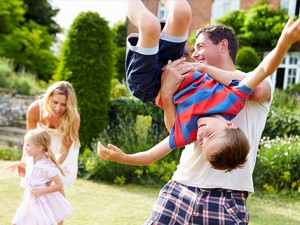Rough & tumble play – Child
 Rough and tumble play satisfies the drive for action and adventure in children. It allows risk taking within safe boundaries.
Rough and tumble play satisfies the drive for action and adventure in children. It allows risk taking within safe boundaries.
Did you know?
Rough and tumble play is necessary for the development and maintenance of social awareness, learning to read and understand the body language and emotions of others, and regulating behaviour.
Add language
Often in the height of rough and tumble play, talking may not be needed. However stories or pictures which include rough housing or rough and tumble play are useful to prompt conversations about how we feel, how other people feel, how we know how they feel and when and why we need to stop. This helps build their vocabulary and thinking and reasoning skills.
Other development
Rough and tumble play builds emotional intelligence and social skills in learning to give and take, practice fairness, cooperation, compassion and self control.
Children who have engaged regularly in rough house, rough and tumble play learn to distinguish between innocent play and aggression. This helps with their social, problem solving and protective behaviour skills.
Adults modeling in rough and tumble play show kids that someone bigger and stronger holds back, shows self control, fairness and empathy so everyone has fun and no one is hurt or bullied or forced to do anything. Calming down with your child at the end of the game is important in helping your child develop self regulation skills.
Variations
Playing chasey or tag, play wrestling, rolling, spinning and dancing can all be rough and tumble play.
Safety
Each child differs in the amount, intensity and duration of rough and tumble play they can handle. Get to know your child’s limits and stop before they reach that limit. It is important that the play is fun and no one is forced to do anything.
Across the ages
All the activities listed on our “Play Ideas” page can be applied across different age groups. See how rough and tumble play can be fun for babies, toddlers and playgroups.
Activities listed under “child” are suitable for children 3 years and older. Children of this age enjoy more complex activities where they can develop their skills and use their imagination while playing with friends.

